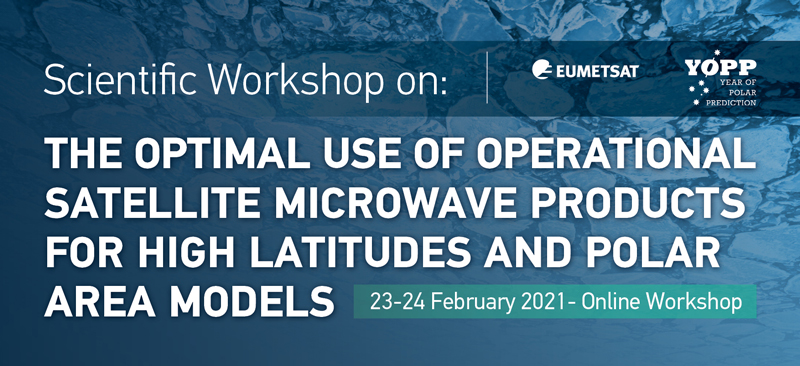
Workshop on the optimal use of operational satellite microwave products
Online: 23-24 February 2021
Scientific Workshop on the Optimal Use of Operational Satellite Microwave Products for High Latitudes and Polar Area Models.


This scientific workshop has the overall purpose to advance the utilisation and impact of operational satellite microwave data in weather, climate, ocean and sea ice prediction and climate reanalyses in the high latitudes and polar areas.
19 August 2021
11 January 2021
Growing concern about climate change amplification and its impact in those regions has recently triggered efforts dedicated to observation and prediction, such as e.g. the WMO WWRP Polar Prediction Project (PPP) and its flagship activity, the Year Of Polar Prediction (YOPP), and the MOSAiC expedition.

Satellite passive microwave sounder and imager measurements from polar orbiting missions are of crucial importance for weather prediction and climate monitoring, in particular in polar and high latitude regions, for atmosphere sounding, atmospheric water as well as surface properties characterisation. They benefit both coupled atmosphere-ocean-sea-ice models and atmosphere in numerical weather prediction (NWP) and climate applications, and atmosphere, ocean and sea ice models in stand-alone mode. The presence in the EPS-SG mission of the MicroWave Sounder (MWS), the MicroWave Imager (MWI) and Ice Cloud Imager (ICI) testify to the importance of those measurements for EUMETSAT and its user community.
Numerical experimentation performed in the framework of the H2020 APPLICATE project and the PPP have, among other results, revealed that at present we do not make optimal use of satellite observations for weather prediction and climate monitoring in polar regions. This is due to factors spanning the satellite products, the techniques for assimilating those products in the NWP systems and the numerical models themselves. Considerable progress has been made recently in each of those areas. Moreover, the wealth of in situ data collected during the Year Of Polar Prediction and the MOSAiC expedition can be exploited to improve the satellite products and the models. Thus, it seems timely to bring together experts from these different areas to foster collaborative work, optimise the important investments being made in development and experimentation of better satellite products and NWP systems.
This workshop calls for the participation and interaction of experts contributing to all elements of the NWP systems: satellite product development, numerical models including coupled atmosphere-ocean-ice models, data assimilation, radiative transfer, in situ observations. Experts working on operational ocean and of sea ice models, stand-alone, as well as coupled, with the atmosphere within NWP systems and climate models, are also invited.
The workshop main themes are:
- Overview of the chain from microwave observations to weather, climate, ocean and sea ice models.
- Overview of the issues with microwave sounder and imager data assimilation.
- Limitations of space-borne instruments e.g. spatial and temporal sampling.
- Uncertainties in the models that affect the uptake of microwave observations in NWP systems: snow and sea ice surfaces, mixed-phase clouds, shallow stable boundary layers.
- Issues with the radiative transfer in particular over snow and sea ice.
- Assimilation techniques.
- Background error co-variances.
- Contribution of additional satellite measurements e.g. scatterometer ss, IR imaging.
- Key in situ observations for validation and tuning of satellite products and NWP systems.
Panel discussions will aim at identifying how the issues identified in various elements of the observing and NWP systems interact; and at orienting and coordinating the most promising approaches towards a global and effective increase in the uptake of microwave observations in NWP systems.
For more details please visit the workshop website